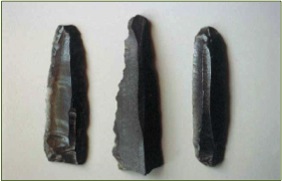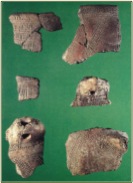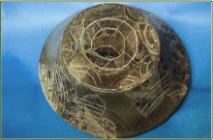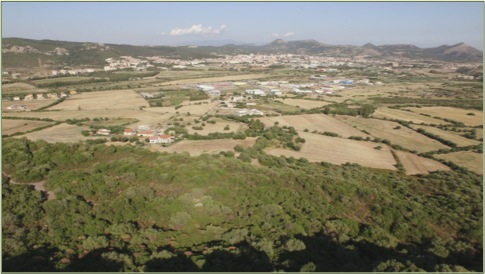Ancient presences in the territory of Carbonia
It is not simple to summarise the ancient history of a vast, complex territory such as Carbonia in a few lines. It has existed since ancient times due to the relationship between land, sea and mines.
The first verified episodes are Neolithic, with caves and domus de janas (the latter also present in the current town, such as the Cannas di Sotto necropolis (fig. 4).
The oldest materials come from the rock shelter of Su Carroppu: they are cardium ceramics (cardium is the shell whose edge was used to decorate the walls of a vase) and tools in obsidian that can be dated up to the 6th century B.C. (fig. 1-2). Documentation from the Tanì grotto is very important.


Other grottoes are documented in Coderra, between Carbonia and San Giovanni Suergiu. The wide diffusion of domus de janas proves the intense human presence: there is also a trace of this in the hut settlement in Barbusi. The domus de janas at Monte Crobu (fig. 3) and the CAI grotto are also of archaeological interest.


In the area of Sirai, later occupied by the Phoenician-Punic settlement there are Neolithic and Copper Age traces: specifically of the Monte Claro culture that confirms its aptitude to occupying high plains.
During the Nuragic age, control of the land and management of its resources developed progressively. The territorial basin, densely occupied, contains its most interesting episode, the Sirai nuraghe, with important Nuragic and Phoenician phenomena of integration.
Monte Sirai - together with Sulky - the key point of the territory (fig. 5). The centuries of happenings end with the Roman conquering of Sardinia, while maintaining episodes of continuation in the Late Republican Age.
Understanding the Roman Age is strongly affected by the history of the control of the city of Sulci and its economical main points (still wheat and the mine). The affairs of Carbonia rotate around this deep change, increasingly intense and rooted in the Imperial Age.

Bibliografia
- Gruppo locale di coordinamento Carbonia, Monumenti aperti, Carbonia.
- M.L. FERRARESE CERUTI, O. FONZO, Nuovi elementi dalla grotta funeraria di Tanì (Carbonia), in SANTONI 1995, pp. 97-115.
- L. MARRAS, Il Museo Archeologico di Carbonia, Sassari.
- C. PERRA, Museo archeologico Villa Sulcis: guida alle esposizioni, Carbonia.
- V. SANTONI (a cura di), Carbonia e il Sulcis. Archeologia e territorio, Oristano.
- V. SANTONI (a cura di), Carbonia e il Sulcis. Archeologia e territorio, Oristano.
- V. SANTONI, L. USAI, Domus de janas in località Cannas di Sotto (Carbonia), in SANTONI 1995, pp. 51-82.
- C. TRONCHETTI, Le problematiche del territorio del Sulcis in età romana, in SANTONI 1995, pp. 263-275.

 VR
VR